Robotic process automation (RPA) is an unstoppable digitization trend, but its complexity is frequently underestimated. In this article, you’ll learn what RPA is and can do, why many RPA projects fail, and how MuleSoft RPA can safely guide your automation initiatives to success throughout the RPA lifecycle.
Automation now: jobs for bots
It seems like magic and the ultimate answer to cross-industry challenges such as innovation pressure and skills shortages: RPA is a software technology that automates repetitive tasks in a cost-efficient way. RPA bots perform routine digital tasks flawlessly, fast, and steadily. They compare prices, answer standard inquiries, prepare payrolls or generate passwords.
All these tedious and error-prone tasks that cost companies tons of time and money while overtaxing and tiring qualified employees in all departments are a thing of the past with RPA. About one-third of all tasks can be automated in at least 60% of jobs, and you can save an average 20% full-time role equivalents after fewer than a year of RPA operation. RPA offers some serious potential.
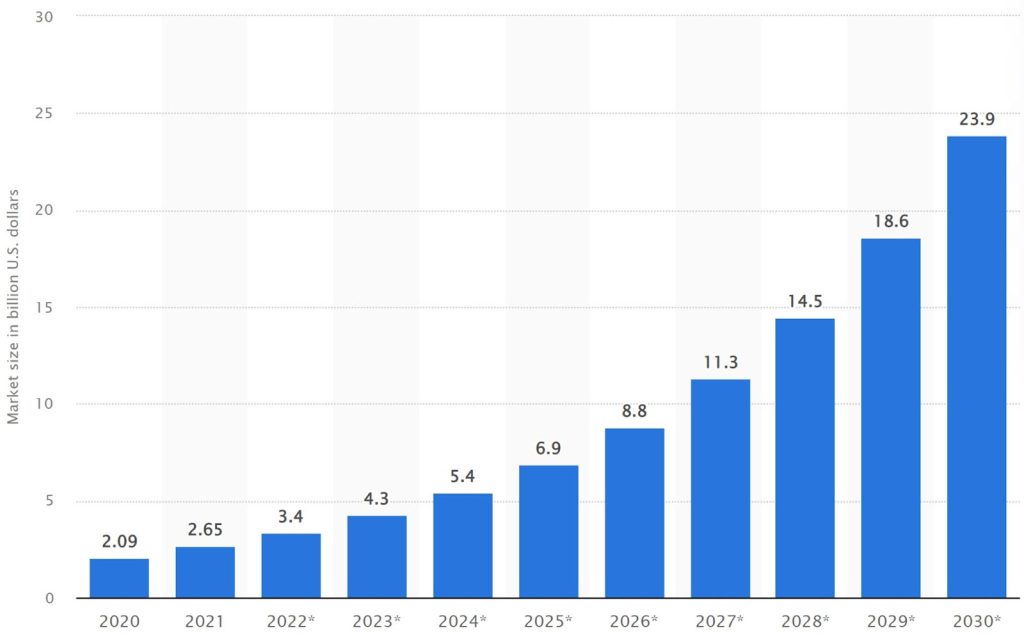
Anyone can RPA: the no-code hype
RPA bots imitate the activities of human users when operating digital systems: they open and close programs, identify content on the screen, and perform mouse clicks or keyboard entries. In doing so, they follow a predefined script that automates the previously manual workflow.
To create these scripts, modern RPA tools typically offer a graphical no-code approach: the required user activities are available as predefined building blocks that are combined step by step into automation workflows using simple drag and drop actions.
This intuitive approach also enables business users to automate their workflows on their own, opening up vast digitization capabilities beyond the limited resources of IT departments. By 2023, major companies will have four times as many citizen developers as professional software engineers.
Fail to scale: common RPA mistakes
Thus, more companies are waving the RPA magic wand, expecting significantly greater efficiency and lower costs in no time at all. But the miracle frequently does not materialize: 30–50% of all RPA initiatives fail, which is quite a disillusioning finding in the wake of the initial hype on the market. And ironically, this is due to the user-friendly approach most automation tools offer.
Ambitious departments often start the topic of RPA on their own initiative. Well, why not? After all, business employees know their workflows best and can actually automate some tasks themselves thanks to no-code. Nevertheless, the results are poor and the problems are pre-programmed. There are 3 reasons why RPA projects fail:
1. Having a business-only mindset
If business departments run RPA as shadow IT, it will lack everything that a professional software project requires: a proper and audit-proof documentation, development and delivery standards, a solid infrastructure, plus ongoing maintenance and monitoring of the RPA bot operations. On top of that, the digital coworkers access and operate in production systems, so the adherence to compliance and security policies is particularly critical. This all sums up to: Don’t do RPA without the IT department.
2. Not having a plan at all
Quickly automating tasks somehow and somewhere is possible, but not very effective. Like any digital project, RPA demands a strategy and a roadmap that is aligned with the company’s overarching goals. Without in-depth planning and analysis, it is highly likely that unprofitable processes will be automated with poor outcomes. As a result, your RPA ventures will hardly ever win the commitment of the top management level and will not be supported in the long term.
3. Losing control
Who is developing the bots? Which tasks are automated? Where and how frequent do the automations run? What business results are they driving? If you can’t answer these questions, you lack overall visibility, centralized control, and evaluation of success. Without these governance aspects, your automation journey becomes a blind ride.
Key success drivers for RPA
The complexity of process automation should never be underestimated. RPA is more than simple task automation. If companies want to fully tap the potential and profitability of RPA, they must plan process automation as an organization-wide IT and business project, set up compulsory project standards, and centrally and securely manage the collaboration of all players. Only then can the impact of RPA unfold on a large scale. These points are critical for RPA success:
Selecting the right processes
Not every process can be automated – and not every process automation pays off. So you need to comprehensively examine which processes can be automated from a technical point of view as well as assessing the economic viability of the automation.
Orchestrating RPA teams
An RPA project requires developers to build and test the RPA bots, but it also needs process owners from the business to identify potential RPA candidates and fill the RPA pipeline, IT administrators to provide the infrastructure and monitor ongoing bot operation, and project managers to control the project flow and keep an eye on costs. All the relevant roles, skills and privileges must be clearly assigned to ensure efficient and secure collaboration of all players involved.
Steering RPA centrally while empowering users across the board
Companies that successfully adopt RPA manage and control their entire automation landscape centrally while ensuring the highest compliance and security standards, as with any IT project. At the same time, they empower business users across all divisions to actively engage in process automation, thus unlocking additional digitization capacities and alleviating the strain on the IT department. They achieve this balance between RPA governance and RPA enablement by taking a platform-based approach and using suitable no-code technologies.
Standardize bot development
An RPA bot is ultimately a piece of software that is designed to reliably meet specific business requirements. Thus, the project phases of the Software Development Lifecycle apply perfectly to the development of high-quality RPA bots. A standardized RPA lifecycle simplifies and directs the course of RPA projects and the teamwork of the players involved while ensuring that RPA delivers optimum business value.
MuleSoft RPA: Manage process automation end-to-end
MuleSoft RPA is a modern enterprise platform for process automation, providing user-friendly no-code tools and powerful robotics technology for successful process automation. Every automation project passes the entire RPA lifecycle. Here’s the key benefits:
- Central management and full control of the company-wide RPA landscape
- Intuitive and systematic user guidance through all phases of an RPA project
- High profitability and financial transparency
- Efficient collaboration of all players and RPA stakeholders
- Standardized, high-quality bot development
- Stable, secure RPA operation
You want to know in detail how the magic works? Join the journey through the RPA lifecycle and the different stages of process automation!
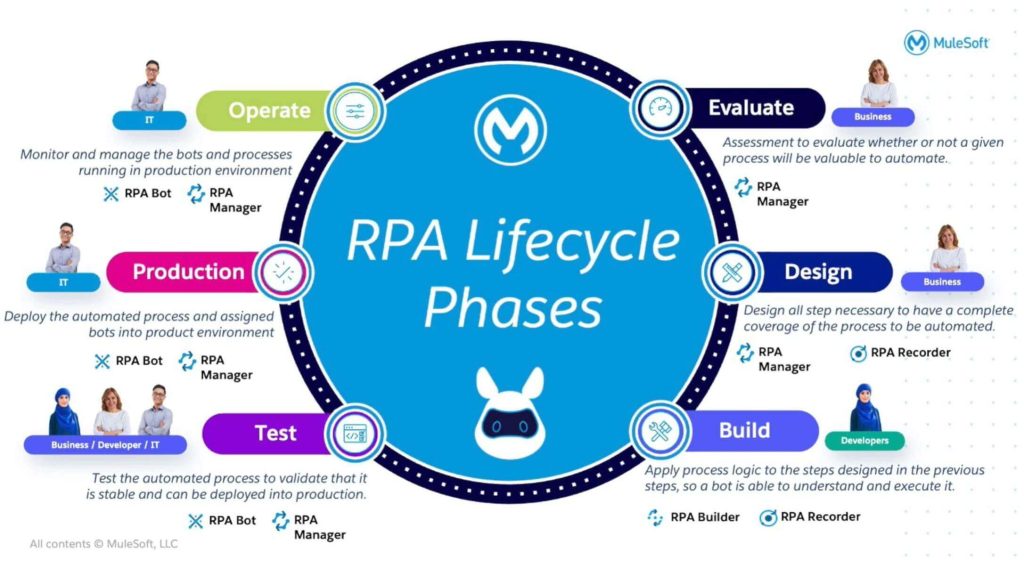
RPA lifecycle phase 1: Evaluation
Assess and prioritize processes
All RPA projects are managed centrally via the cloud-based server RPA Manager. This is where the automation journey begins: In the first phase of the RPA lifecycle, persons with in-depth process knowledge, such as business unit managers or process managers, check whether potential process candidates are actually suitable for automation.

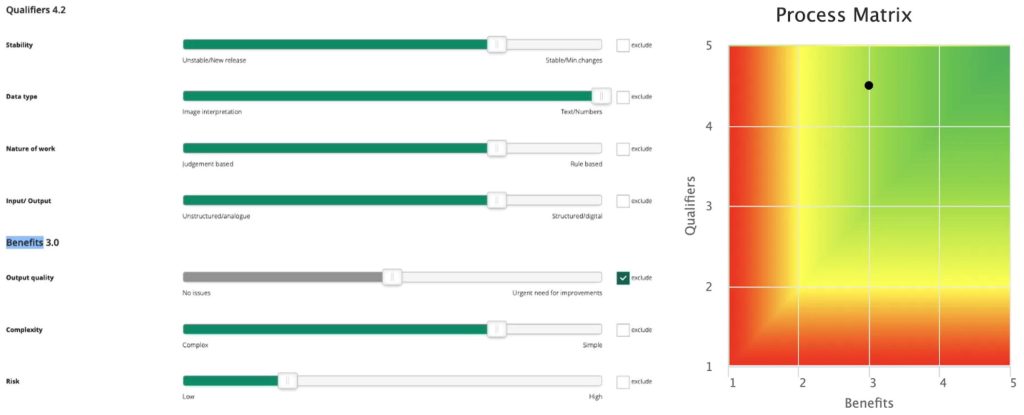

Release processes and prepare them for automation
Reliable project control through the RPA lifecycle includes release steps for each next project phase. After successful evaluation, the process owner releases the process for automation and hands it over to the responsible project manager, who prepares all the settings required for RPA development, puts together the RPA team and performs a cost-benefit analysis.

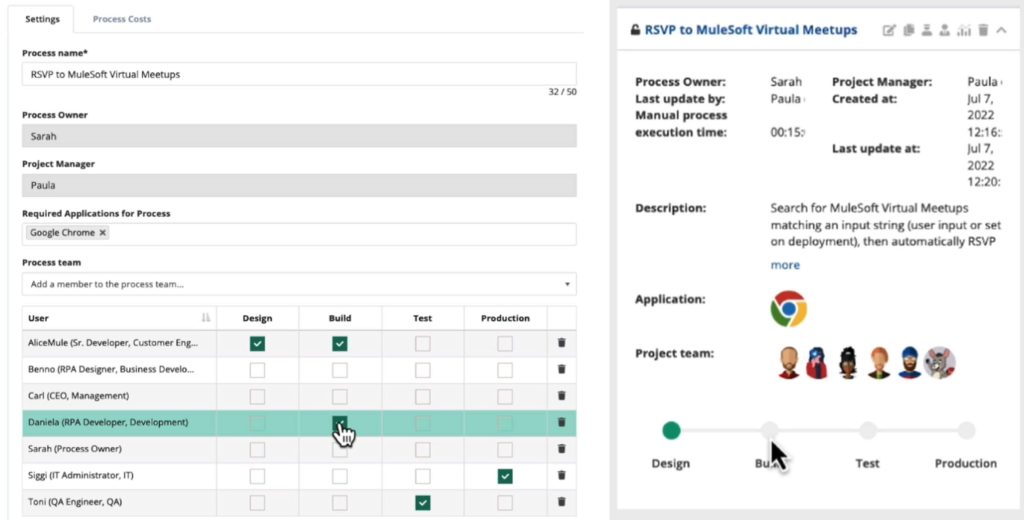
Manage RPA teams, roles, and privileges
RPA projects involve many players performing different tasks, ranging from process analysts to bot developers to IT administrators. A fine-grained and flexible role and privilege concept specifies and manages responsibilities and access permissions, facilitating a controlled and cross-phase collaboration of all people involved in the development process.


Calculate automation costs and RPA ROI
RPA project management also includes business analyses that reveal the profitability of planned and ongoing process automations. This enables RPA project managers to easily overview the monetary success of automation initiatives and report this information to relevant stakeholders.

RPA lifecycle phase 2: Design
Model processes
In the design phase of the RPA Lifecycle, the business process is mapped as a flowchart in the standard graphical language Business Process Model Notation (BPMN). The BPMN flowchart documents the sequential steps of the high-level process and serves as the “skeleton” for the subsequent RPA implementation. Besides bot tasks, BPMNs can include manual user tasks for attended bot operations: here, bot and human activities alternate and complement during the course of the process.

Record RPA requirements
Once the business process is modeled in BPMN, it is filled with detailed information for the development of the RPA bots. The RPA Recorder simply records the user activities to be automated, e.g. the RPA requirements. This easy to use recording feature significantly accelerates bot development and was a key factor in MuleSoft’s positioning as a Visionary in the Gartner Magic Quadrant for RPA 2022.



RPA Lifecycle Phase III: Build
Implement RPA workflows
Now it’s the bot developers’ turn: For each bot task in the BPMN process, a robust RPA workflow is to be created based on the pre-recorded RPA requirements. MuleSoft RPA Builder is an intuitive and powerful low-code tool with a wide range of automatable user activities. These are available via a comprehensive action step toolbox and include
- screen recognition technologies such as image and pattern search
- intelligent OCR for reading text from application interfaces, images, and PDFs
- typical user actions such as mouse clicks or keystrokes
along with numerous other RPA building blocks that make it easy to automate common office applications and to map the logic of digital business workflows. Local functional testing for each step and bot workflow ensures high-quality bot development.
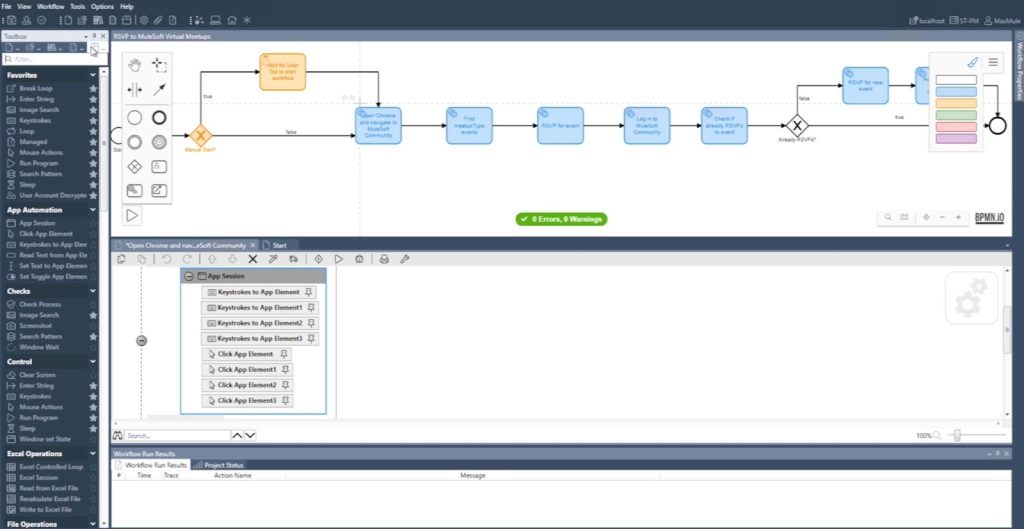



RPA lifecycle phase 4: Test
Assure RPA quality before going live
Like any software, the fully implemented process automation is tested before it is accepted for operation. For this purpose, the RPA process runs on bot instances through various test plans that cover possible “real-world scenarios”. The test execution can be tracked in real time.In case of failed test runs, the process moves back to the build phase, and developers can use an automatically generated analysis package for troubleshooting (see RPA alerting and troubleshooting).
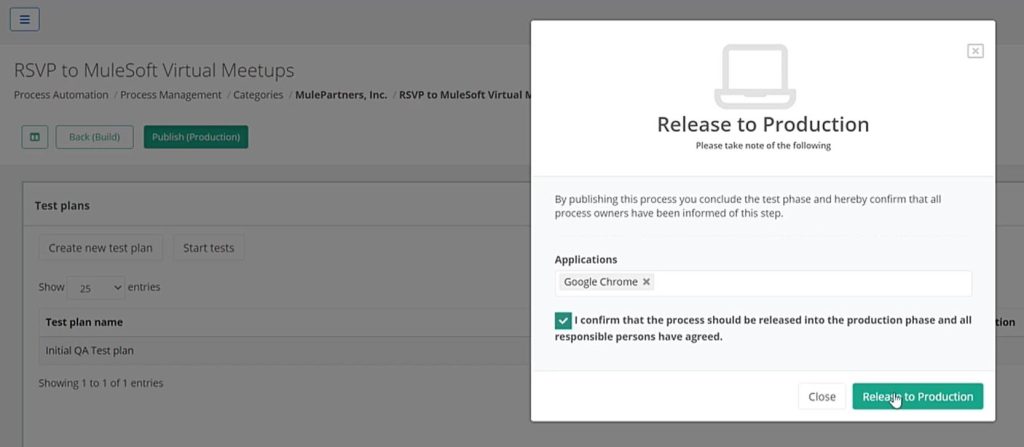
RPA lifecycle phase 5: Production
Plan and start process automation
Just ahead to go: Now is the time to specify when and how often the process automation should be executed – and on which bot instances it should run.
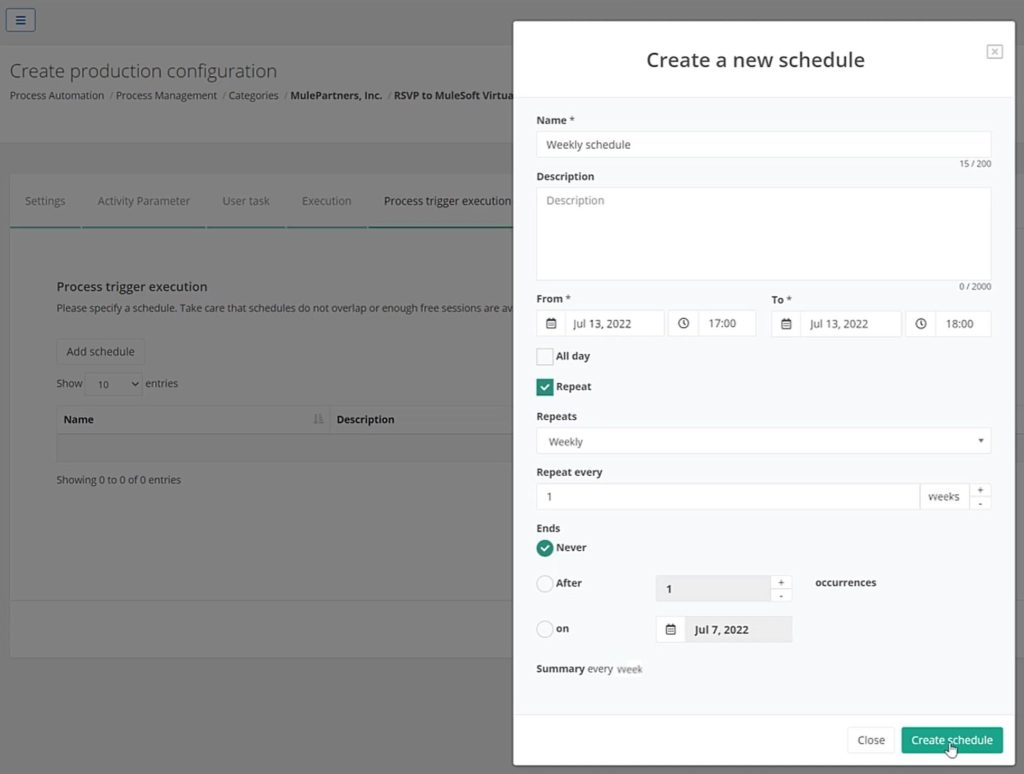

RPA Lifecycle Phase VI: Operation
Monitor bot operations
Your process automation is running – the RPA bots are at work! You can watch the operation of individual bots via livestream or analyze all running process automations at a glance using dashboards.

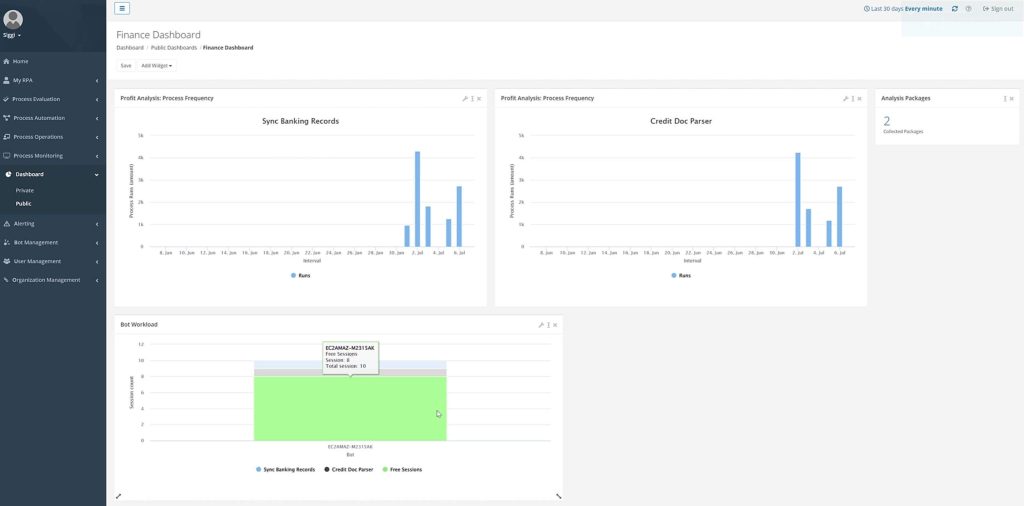
RPA alerting and troubleshooting
Stable RPA operation requires reliable recovery tools. If RPA bots run into errors, the alerting module immediately informs the responsible IT administrators – and a detailed analysis package helps RPA developers to quickly and precisely fix the issue.


RPA lifecycle: Your automation journey starts now
Now that you know what the RPA lifecycle looks like, are you ready to start your own automation journey? Our free training guides you step by step with exercises and video tutorials through all RPA project steps, so get started with MuleSoft RPA.









